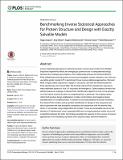| dc.contributor.author | Jacquin, Hugo | en_US |
| dc.contributor.author | Gilson, Amy | en_US |
| dc.contributor.author | Shakhnovich, Eugene | en_US |
| dc.contributor.author | Cocco, Simona | en_US |
| dc.contributor.author | Monasson, Rémi | en_US |
| dc.date.accessioned | 2016-06-14T18:53:25Z | |
| dc.date.issued | 2016 | en_US |
| dc.identifier.citation | Jacquin, Hugo, Amy Gilson, Eugene Shakhnovich, Simona Cocco, and Rémi Monasson. 2016. “Benchmarking Inverse Statistical Approaches for Protein Structure and Design with Exactly Solvable Models.” PLoS Computational Biology 12 (5): e1004889. doi:10.1371/journal.pcbi.1004889. http://dx.doi.org/10.1371/journal.pcbi.1004889. | en |
| dc.identifier.issn | 1553-734X | en |
| dc.identifier.uri | http://nrs.harvard.edu/urn-3:HUL.InstRepos:27320431 | |
| dc.description.abstract | Inverse statistical approaches to determine protein structure and function from Multiple Sequence Alignments (MSA) are emerging as powerful tools in computational biology. However the underlying assumptions of the relationship between the inferred effective Potts Hamiltonian and real protein structure and energetics remain untested so far. Here we use lattice protein model (LP) to benchmark those inverse statistical approaches. We build MSA of highly stable sequences in target LP structures, and infer the effective pairwise Potts Hamiltonians from those MSA. We find that inferred Potts Hamiltonians reproduce many important aspects of ‘true’ LP structures and energetics. Careful analysis reveals that effective pairwise couplings in inferred Potts Hamiltonians depend not only on the energetics of the native structure but also on competing folds; in particular, the coupling values reflect both positive design (stabilization of native conformation) and negative design (destabilization of competing folds). In addition to providing detailed structural information, the inferred Potts models used as protein Hamiltonian for design of new sequences are able to generate with high probability completely new sequences with the desired folds, which is not possible using independent-site models. Those are remarkable results as the effective LP Hamiltonians used to generate MSA are not simple pairwise models due to the competition between the folds. Our findings elucidate the reasons for the success of inverse approaches to the modelling of proteins from sequence data, and their limitations. | en |
| dc.language.iso | en_US | en |
| dc.publisher | Public Library of Science | en |
| dc.relation.isversionof | doi:10.1371/journal.pcbi.1004889 | en |
| dc.relation.hasversion | http://www.ncbi.nlm.nih.gov/pmc/articles/PMC4866778/pdf/ | en |
| dash.license | LAA | en_US |
| dc.subject | Biology and Life Sciences | en |
| dc.subject | Molecular Biology | en |
| dc.subject | Macromolecular Structure Analysis | en |
| dc.subject | Protein Structure | en |
| dc.subject | Biochemistry | en |
| dc.subject | Proteins | en |
| dc.subject | Protein Structure Prediction | en |
| dc.subject | Computational Techniques | en |
| dc.subject | Split-Decomposition Method | en |
| dc.subject | Multiple Alignment Calculation | en |
| dc.subject | Physical Sciences | en |
| dc.subject | Physics | en |
| dc.subject | Thermodynamics | en |
| dc.subject | Entropy | en |
| dc.subject | Molecular Biology Techniques | en |
| dc.subject | Sequencing Techniques | en |
| dc.subject | Sequence Analysis | en |
| dc.subject | Sequence Alignment | en |
| dc.subject | Protein Structure Comparison | en |
| dc.subject | Protein Sequencing | en |
| dc.subject | Mathematical and Statistical Techniques | en |
| dc.subject | Statistical Methods | en |
| dc.subject | Forecasting | en |
| dc.subject | Mathematics | en |
| dc.subject | Statistics (Mathematics) | en |
| dc.title | Benchmarking Inverse Statistical Approaches for Protein Structure and Design with Exactly Solvable Models | en |
| dc.type | Journal Article | en_US |
| dc.description.version | Version of Record | en |
| dc.relation.journal | PLoS Computational Biology | en |
| dash.depositing.author | Gilson, Amy | en_US |
| dc.date.available | 2016-06-14T18:53:25Z | |
| dc.identifier.doi | 10.1371/journal.pcbi.1004889 | * |
| dash.contributor.affiliated | Gilson, Amy Ilana | |
| dash.contributor.affiliated | Shakhnovich, Eugene | |


